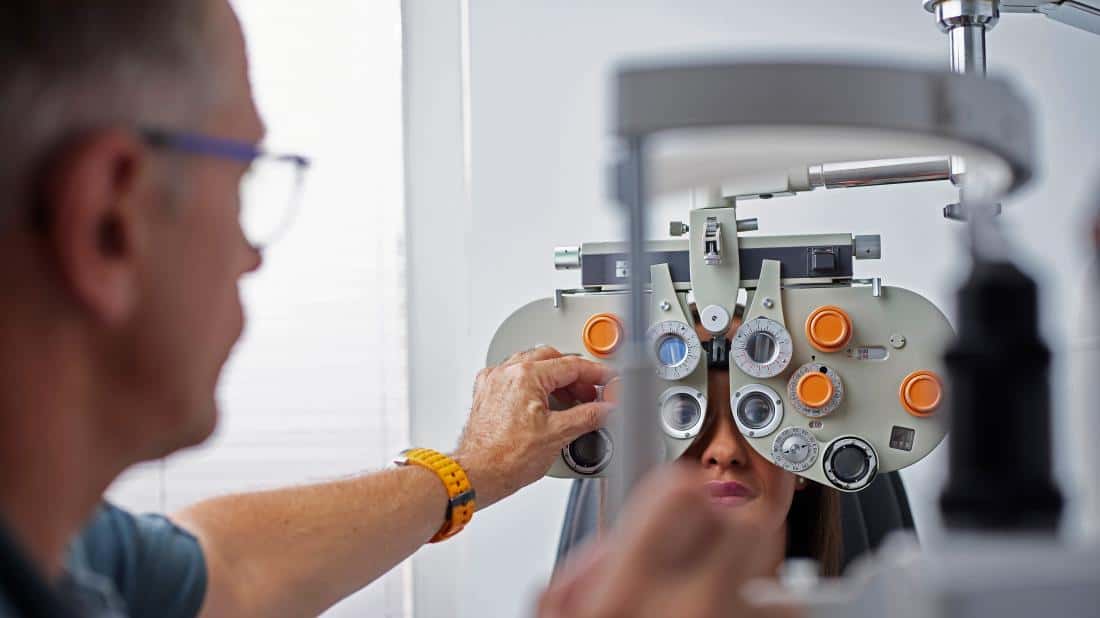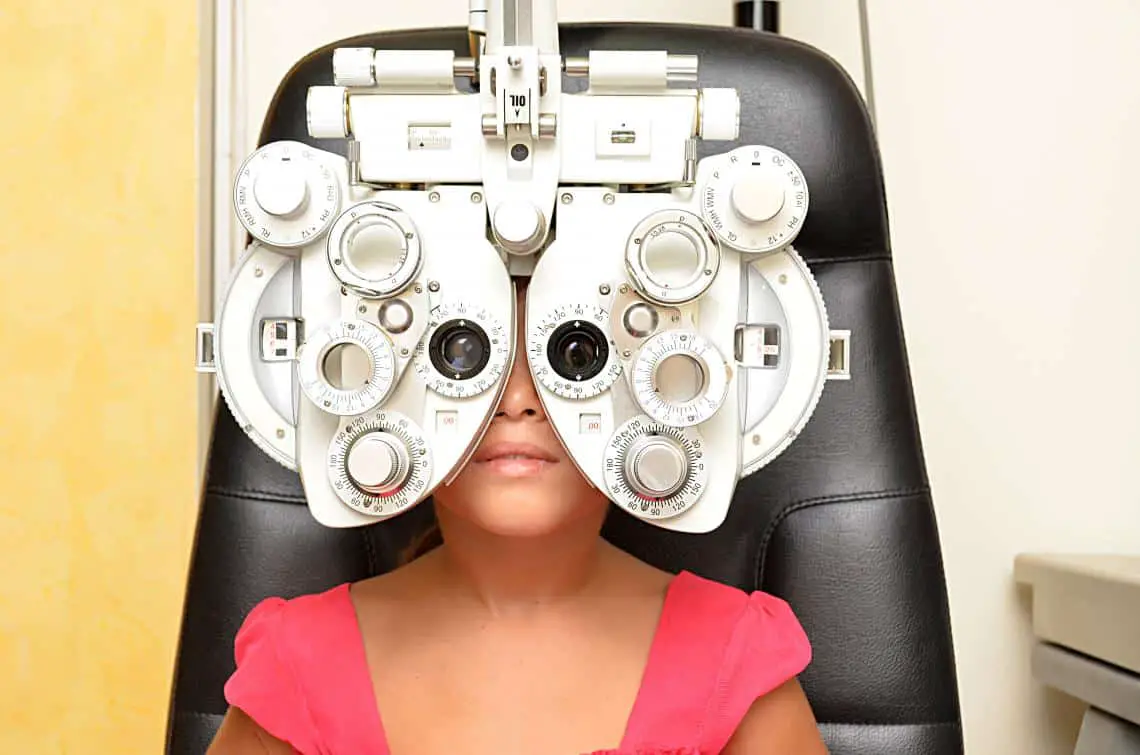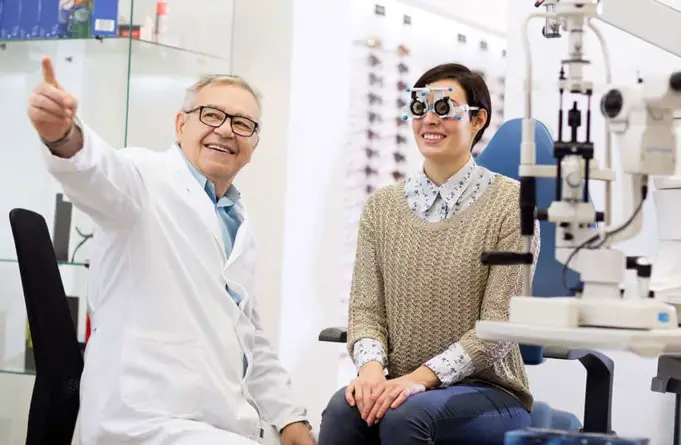The medical term “optometry” originates from the Greek words ὄψις (opsis; “view”) and μέτρον (metron; “something used to measure,” “measure,” “rule”). The word gained entry into the language when the instrument for measuring vision was referred to as an optometer (before usage of terms such as phoropter or refractor).
The root word “opto” is a short form sourced from the Greek word “ophthalmos” meaning, “eye.” Like most healthcare professions, the training and certification of optometrists are regulated in several countries.
Optometric professionals and optometry-affiliated organizations communicate with governmental agencies, other healthcare practitioners, and the community to provide eye and vision care.
The World Council of Optometry, the World Health Organization, and about 75 optometry establishments from more than 40 countries worldwide have adopted a standard definition of an optometrist. Optometry is a medical profession that is independent, educated, and regulated (licensed/registered).
Optometrists are a category of health practitioners of the eye and visual system who deliver complete eye and vision care: refraction and dispensing detection/diagnosis and management or treatment of eye illnesses, and the reinstation of the state of the visual system.
History of Optometry
The background of optometry is connected to the advancement of vision science, optics, optical aids, optical instruments, imaging techniques, related eye care professions. We can easily trail the history of “optometry” (refracting opticians) back to the early studies on optics and image layout or set up by the eye.
The sources of optical science date back as far as a few millenniums ago, as proof of the presence of lenses for decoration has been discovered in Greece and the Netherlands. It is not known when the first spectacles were produced.
The British historian and scientist, Sir Joseph Needham, in his “Science and Civilization in China,” revealed that the most ancient mention of spectacles was in Venetian guild regulations circa 1300.
He posited that the seldom claim that spectacles were first made in China might have originated from a paper by Laufer. Per Needham, the report by Laufer had many loopholes.
Laufer’s document references were not in the authentic copies but were written during the Ming dynasty. Ancient Chinese sources stated that the eyeglasses were imported.
On the other hand, research carried out by David A. Goss in the United States reveals they may have invented in the late 13th century in Italy as written in a manuscript from 1305 where a monk from Pisa named Rivalto said, “It is not up to 20 years since the art of making eyeglasses was discovered”. Spectacles were produced in Italy, Germany, and the Netherlands by 1300. Needham said Gary spectacles were first made not long after 1286.
Benito Daza de Valdes published the first complete book on opticians in 1623, where he wrote eyeglasses’ use and fitting. In 1692, William Molyneux published a book on optics and lenses where he expressed his thoughts on myopia and issues connected to the close-up vision. Claudius Ptolemy and Johannes Kepler, both scientists, also played a role in the development of optometry.
Kepler found out how the retina in the eye produces vision. From 1773 until around 1829, Thomas Young found out the disability of astigmatism. It was George Biddell Airy who manufactured glasses to rectify that issue that included a sphero-cylindrical lens.
Although the term optometer was seen in the 1759 book A Treatise on the Eye: The Manner and Phenomena of Vision by Scottish physician William Porterfield, it wasn’t until the early twentieth century in the United States and Australia that “optometry” started being utilized to define the profession.
However, by the early twenty-first century, outlining the difference with dispensing opticians, it had become the universally acknowledged term.
Education, licensing, and range of practice
Optometry is officially acknowledged in many territories. Many of them have regulations regarding training and practice. Like several other healthcare practitioners, optometrists are mandated to take part in ongoing continuing education courses to stay updated on the most current care standards.
The World Council of Optometry possesses a web resource that supplies relevant eye care practitioners’ information for more than 46 countries.
Optometry in selected countries

Optometry in Nigeria
In Nigeria, optometry is overseen by the Optometry and Dispensing Opticians Registration Board of Nigeria. This was founded and established under the Optometry and Dispensing Opticians ( Registration ETC ) Act of 1989 (Cap O9 Laws of Federation of Nigeria 2004).
The Boards periodically publishes lists of recognized qualifications and training institutions in the federal government gazette. The Doctor of Optometry degree is awarded on completion of a six-year training at one of the accredited universities in Imo, Edo, and Abia states.
Optometry in India
In 2010, it was suggested that India needs 115,000 optometrists, where the country has roughly 9,000 optometrists (trained for four years) and 40,000 optometric assistants/vision technicians (trained for two years).
To avoid blindness or visual defects, additional well-trained optometrists are needed in India. The description of optometry varies significantly in several countries.
India needs more optometry educational institutions offering four-year degree programs, with a curriculum similar to that used in those countries where the practice of optometry is statutorily regulated and well-founded with a universally approved definition.
In 2013, it was revealed in the Indian Journal of Ophthalmology that dismal spectacle acquiescence amongst school children in rural Pune led to considerable loss of vision. In 2015, it was stated in the Optometry and Vision Science that optometrists need to be increasingly engaged in delivering essential optometry services like binocular vision and low vision.
Presently, there are above fifty schools of optometry in India. In 1958, two optometry schools were founded, one at Gandhi Eye Hospital, Aligarh in Uttar Pradesh, and the second one at Sarojini Devi Eye Hospital, Hyderabad in Telangana, under the second five-year plan by the Director-General of Health Services of Government of India. These schools offered diplomas in optometry programs designed to last for two years and is validated by State Medical Faculties.
Eventually, four more schools were established across India, situated at Sitapur Eye Hospital, Sitapur in Uttar Pradesh, Chennai (formerly Madras) in Tamil Nadu, Bengalooru (formerly Bangalore) in Karnataka, and Regional Institute of Ophthalmology, Thiruvananthapuram (formerly Trivandrum) in Kerala.
The Elite School of Optometry (ESO) was founded in 1985 in Chennai. It was the first institution to offer a four-year degree program. Academic degrees including Bachelor of Optometry, Master of Optometry, and Doctor of Philosophy in Optometry are given in India by the universities approved by the University Grants Commission (India).
This is a statutory body whose responsibility is the maintenance of standards of higher education in India. Throughout India, optometrists are advised to register with the Optometry Council of India, a self-regulatory body founded under the Indian Company Act.
Optometry in Hong Kong
The Optometrists Board of the Supplementary Medical Professions Council oversees the profession in Hong Kong. Optometrists are listed in distinct sections of the register due to their training and skill set. Registrants are prone to restrictions depending on the section they are listed in.
Those who succeed in the examination on refraction organized by the Board may be registered to Part III, thereby limiting them to practice only work affiliated to refraction. Holders of a Higher Certificate in Optometry or those who have completed the Board’s optometry examination may be registered to Part II, thereby limiting their utilization of diagnostic agents, but may otherwise operate freely.
Part I optometrists may operate without restrictions and commonly possess a bachelor’s degree or a Professional Diploma. There are virtually 2000 optometrists listed in Hong Kong, half of which is part I. There is one Part I optometrist to roughly 8000 citizens. The Polytechnic University has the only optometry school. It graduates approximately 35 Part I optometrists annually.
Optometry in Russia
In Russia, optometry education has been approved by the Federal Agency of Health and Social Development. There are just two educational establishments that teach optometry in Russia: Saint Petersburg Medical Technical College, formerly known as St. Petersburg College of Medical Electronics and Optics, and The Helmholtz Research Institute for Eye Diseases. The two schools belong to and are overseen or controlled by the Ministry of Health.
The optometry program is a four-year course. It encompasses one to two science foundation years; one year concentrated on clinical and proficiency skills, and a year of clinical rotations in hospitals. Graduates sit for college/state examinations and are then awarded a specialist diploma.
This diploma’s validity lasts for five years and is mandated to be renewed every five years after additional training at state-accredited programs.
The range of practice for optometrists in Russia encompasses refraction, contact lens fitting, spectacles design, lens fitting, low vision aids, foreign body extraction, and referrals to other optical professionals after clinical condition diagnoses.
Optometry in the UK
Optometrists in the United Kingdom are generally overseen by the General Optical Council under the Opticians Act 1989 and distinct from medical practitioners. Registration with the GOC is compulsory before practicing optometry in the UK.
Members of the College of Optometrists (incorporated by a Royal Charter approved by Her Majesty Queen Elizabeth II) may make use of the suffix MCOptom. The National Health Service offers free vision tests and spectacle vouchers for children and those on dismal incomes.
The aged and those suffering from some chronic conditions like diabetes get free routine tests. Treatment of eye conditions such as glaucoma and cataracts is free and examined during standard eye diagnosis.
In the United Kingdom, optometrists are mandated to conclude a 3-4 (Scotland) year undergraduate honors degree succeeded by at least a one-year internship, where they conclude clinical practice under a qualified and experienced practitioner’s supervision.
The pre-registration candidate is awarded several quarterly evaluations during this year, frequently including short-term posting at a hospital. On completing all of these assessment exercises, the individual is expected to sit for a final one-day set of examinations.
After the successful conclusion of these evaluations and having finished one year’s supervised practice, the candidate is qualified to be listed as an optometrist with the General Optical Council (GOC). Should they so desire, they are entitled to be a member of the College of Optometrists?
Twelve universities have Optometry programs in the UK: Anglia Ruskin, Aston, Bradford, Cardiff, City, Glasgow Caledonian, Hertfordshire, Manchester, University of Plymouth, Ulster University at Coleraine, University of Portsmouth, and the University of the West of England.
In 2008, the UK took a step further to offer the Doctor of Optometry postgraduate program. This program became available at the Institute of Optometry in London in partnership with London South Bank University. The Doctor of Optometry postgraduate degree is also offered at Aston University, another UK institution,.
In 1990, a survey of British medical professionals’ opinions pertaining to the services carried out by British optometrists was conducted by Agarwal at City, University of London.
Most of the respondents supported optometrists furthering their professional responsibility by managing external eye conditions and prescription of wide-spectrum topical antibiotics through further training and certification.
Since 2009, optometrists in the UK have to go through further postgraduate training and qualifications to prescribe medications to treat and manage eye conditions.
There are presently three registerable specialties:
- Additional supply specialty: To order for and provide in an emergency a range of drugs in addition to those already ordered or provided by a conventional optometrist
- Supplementary prescribing specialty: To treat a patient’s clinical condition and prescribe medicines in concordance to a clinical management outline established in addition with an independent prescriber, such as a GP or ophthalmologist or qualified optometrist
- Independent prescribing specialty: To be responsible for the clinical evaluation of a patient, set up a diagnosis, and ascertain the clinical management needed, including prescribing where necessary.
Optometry in Canada
In Canada, Doctors of Optometry (OD) usually conclude four years of undergraduate studies, succeeded by four to five years of graduate optometry studies, approved by the Accreditation Council on Optometric Education. There are two such schools of optometry in Canada: the University of Waterloo and the Université de Montreal.
Canada also acknowledges degrees from the twenty US schools. In Canada, Doctors of Optometry must sit for the national written and practical board exams. Moreover, optometrists are mandated to become licensed in the territory in which they desire to practice.
Oversight of professions is within provincial jurisdiction. Therefore, oversight of optometry is peculiar to individual provinces and territories. Optometrists are permitted by the College of Optometrists of Ontario.
The profession is represented by the Canadian Association of Optometrists. In Ontario’s province, the Ontario Association of Optometrists is the official representative of optometrists to the provincial government.
In Canada, Optometrists receive training and licensing to be primary eye care providers. They deliver optical and medical eye care. They can diagnose and treat the majority of ocular diseases and can prescribe both topical and oral medications.
Optometry in the USA

Optometrists are Doctors of Optometry (OD) who typically operate as primary eye care providers. They deliver complete optical and medical eye care, but they do not usually carry out surgeries. Their training and licensing enable them to prescribe every topical medication (eye drops), several oral medications, as well as administering diagnostic agents.
In some states, optometrists may also be licensed to carry out specific types of eye surgery. Optometrists are Doctors of Optometry (OD) who may prescribe glasses and contacts to correct refractive defects such as myopia, hyperopia, presbyopia, astigmatism, and double vision.
They treat sight development in children, including amblyopia diagnosis/treatment. Some carry out vision therapy. They are trained and licensed by the state to diagnose and manage any eye disease and their affiliations with systemic health.
Prevalent eye conditions managed include infections (bacterial/viral), allergy, inflammation (uveitis), diabetic/hypertensive retinopathy, macular degeneration, and many more. They may also eliminate ocular foreign bodies and order blood panels or imaging studies (CT/MRI).
However, optometrists are not trained to carry out invasive surgery (i.e., cataract/retina surgery) as ophthalmologists do. Although, in Oklahoma and Louisiana, optometrists may perform minor surgeries within the eye’s rear section. Moreover, the legislation allows optometrists in Oklahoma and Kentucky to carry out specific laser procedures.
Doctors of optometry in the United States are overseen by state boards, which differ from state to state. The Association of Regulatory Boards of Optometry (ARBO) aids these state board licensing bodies to control optometry practice.
Optometrists must conclude all course work and graduate from a recognized College of Optometry. This includes success in all parts of the national board examinations and local jurisprudence examinations, which differ by state.
Doctors of Optometry (OD) usually finish four years of undergraduate studies, then four years of eye-specific training. Some go further with an elective year of study in an area of specialty.
Training occurs in colleges of optometry, hospitals, clinics, and private practices. Instructors can be optometrists, ophthalmologists, or professors (Ph.D.).
The program encompasses classroom and clinical training in geometric, physical, physiological, and ophthalmic optics, specialty contact lens evaluation and fitting, general anatomy, ocular anatomy, ocular disease, pharmacology, ocular pharmacology, neuroanatomy and neurophysiology of the visual system, pediatric visual development, gerontology, binocular vision, color vision, form, space, movement and vision perception, systemic disease, histology, microbiology, sensory and perceptual psychology, biochemistry, statistics, and epidemiology. Optometrists are mandated to go through continuing education credit hours to maintain licensure.












